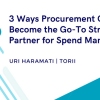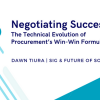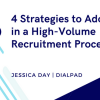Procurement today is a different game. Once viewed as a back-office task, it has emerged as a key differentiator and driver of business value. And to execute it well requires totally new ways of thinking and acting.
Best-in-class organisations understand this. And they are tapping technology, big data and digital networks to fuel a simple, more collaborative source-to-pay process that is changing the game.
Moving Beyond Savings
What defines source-to-settle excellence? It used to be that if you delivered cost savings and process efficiencies, you earned the title “best-in-class.” While these metrics are still core to what procurement is measured on and expected to deliver, leading organisations are moving beyond this.
"The pressure on procurement organisations to do more for less continues without any abatement in the foreseeable future", says Chris Sawchuk, Principal and Global Procurement Advisory Practice Leader for independent research firm The Hackett Group. “To do this, they cannot just run faster and work longer anymore. They have to continue to elevate and broaden the value of supply management beyond traditional perspectives; become more agile to counter the effects of disruptive market forces; and reimagine our supply management function in a fully digital world."
What are procurement leaders doing to deliver on this? A recent analysis of more than $350 billion in spend data for companies connected to the Ariba Network uncovered a few things:
- Approach source-to-pay as an end-to-end process, not a series of discrete tasks
- Manage all of their spend through an integrated platform rather than point solutions
- Use technology to fuel greater collaboration, not just automate tasks
- Connect to networks to access intelligence, not just transact
Going Digital
Best-in-class companies are successfully leveraging data and digital networks to aggregate, analyse and enrich data across business units and geographical regions. And this helps them do a better job managing their procurement operations and working capital, identifying alternative savings opportunities, evaluating risks in the supply chain and collaborating with suppliers.
It also helps drive bottom-line results. Because of their willingness to think outside the box and take a technology-enabled, data-driven approach to procurement, best-in-class organisations have more spend under management and deliver greater savings and are able to do more with less. Companies in the top 25 per cent of the SAP Ariba Benchmark study, for instance:
- Achieve $2.9 million efficiency savings per $1 billion in spend through a lower operating cost structure (0.38 per cent procurement cost of total spend versus 0.67 per cent for average performers).
- Are supported by 36 per cent fewer FTEs, which translates to a $1.1 million in savings per $1 billion in spend (22.6 FTEs per $1 billion spend vs. 35.2 for average performers).
- Extract more value, 70 per cent higher savings per $1 billion in spend, which translates to $32 million per billion in spend.
Changing with the Times
As procurement continues to evolve, so too must the people. Change isn’t easy. But procurement leaders need to embrace and drive this change across their organisations. Top performers already are doing this, focusing on more strategic activities, and in the process, earning a seat at the leadership table and becoming a trusted advisor to the business.
And it’s making a difference.
Fueled by digital networks and technologies, best-in-class procurement organisations are taking the lead in integrating business processes and collaborating across functions in entirely new ways that create value. Many of those connected to the Ariba Network, for example, are helping to manage the financial supply chain, turning payables into a profit centre because they have real-time visibility into whether an invoice is okay to pay and whether it has been matched against purchase orders and contracts. Or extending days payable outstanding to improve the overall balance sheet while at the same time offering early payment discounts to suppliers to mitigate both financial and supply risk.
And with the automation of core processes that these technologies make possible – from sourcing and procurement to payables and risk management – procurement can finally be freed from the basic blocking and tackling of negotiating agreements, managing suppliers, and executing orders to spending more time collaborating with suppliers, developing alternative supply resources, co-innovation, and driving multi-year roadmaps to create value.
This is what defines best-in-class today. And it will ultimately determine the winners tomorrow.







